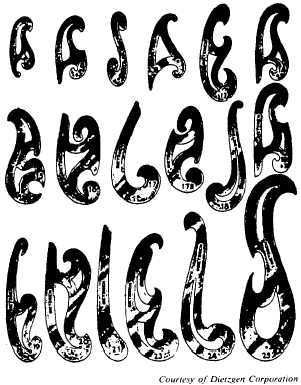45.127X
Figure 2-14.-French curves.
Figure 2-14 shows an assortment of french curves.
In such an assortment you can find edge segments
that can be fitted to any curved line that you need
to draw.
French curves should be cared for and stowed
in the same manner as triangles.
DRAWING INSTRUMENT SETS
So far we have discussed only those instru-
ments and materials that you will need for
drawing straight lines (with the exception of
french curves). Many drawings that you will
prepare will require circles and circular arcs. For
this purpose, instruments contained in a drawing
instrument set are used. Many types of drawing
instrument sets are available; however, it is
sometimes difficult to judge the quality of
drafting instruments by appearance alone. Often
their characteristics become evident only after they
are used.
The drawing instrument set shown in figure
2-15 is typical of those sets found in the standard
draftsman kit. The following sections describe
these instruments. Some special-purpose instru-
ments not found in the set will also be described.
They may be purchased separately or found in
other instrument sets.
Compasses
Circles and circular curves of relatively short
radius are drawn with COMPASSES. The large
pivot joint compass (fig. 2-15C) is satisfactory for
drawing circles of 1 in. to about 12 in. in diameter
without an extension bar. The pivot joint provides
enough friction to hold the legs of the compass
in a set position. One of the legs is equipped with
a setscrew for mounting either a pen (fig. 2- 15B)
or a pencil attachment on the compass. There is
also an extension bar (fig. 2-15D), which can be
inserted to increase the radius of the circle drawn.
The other type of compass found in the
drawing instrument set is the bow compass
(fig. 2-15K and 2- 15L). Many experienced drafts-
men prefer the bow compass over the pivot joint
compass. The bow compass is much sturdier and
is capable of taking the heavy pressure necessary
to produce opaque pencil lines without losing the
radius setting.
There are two types of bow compasses. The
location of the adjustment screw determines the
type. The bow pen (fig. 2-15K) and bow pencil
(fig. 2-15L) are the center adjustment type,
whereas the bow instruments shown in figure 2-16
are the side adjustment type. Each type comes in
two sizes: large and small. Large bow compasses
are usually of the center adjustment type,
although the side adjustment type is available. The
large bow compasses are usually about 6 in. long;
the small, approximately 4 in. long. Extension
bars are available for large bow compasses. Bow
compasses are available as separate instruments,
as shown in figures 2-15 and 2-16, or as
combination instruments with pen and pencil
attachments.
Most compasses have interchangeable needle-
points. The conical or plain needlepoint is used
when the compass is used as dividers. The
shoulder-end needlepoint is used with pen or
pencil attachments.
When many circles are drawn using the same
center, the compass needle may tend to bore an
oversized hole in the drawing. To prevent these
holes, use a device called a horn center or center
disk (fig. 2-151). This disk is placed over the center
point. The point of the compass needle is then
placed into the hole in its center.
2-12



